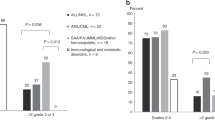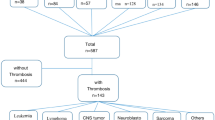Abstract
We performed a prospective trial investigating the feasibility of a double lumen port access in 26 patients with hematological malignancies or solid tumors receiving either standard conditioning (n = 9, median age 49 years (range 19–65)) or dose-reduced conditioning (n = 17, median age 56 years (range 35–66)) followed by allogeneic blood stem cell transplantation. The port system was implanted within 3 months (n = 20, range 7–91 days) before transplantation or as indicated at different time points after transplantation (n = 6, range 28–680 days). Most infusions, including the graft itself and all blood drawings, were performed via the port. Over a cumulative duration of 5622 days (1310 days after standard conditioning (range 56–349) and 4431 days after dose-reduced conditioning (range 49–489)) two port systems of patients receiving standard conditioning were removed due to early postimplantation pocket infection on day 6 and 8 after insertion, respectively. In the dose-reduced conditioning group only one late removal (day 287) of a port was required. Most of the patients in both groups reported less pain and a higher degree of comfort compared to peripheral or central venipuncture. The use of double lumen port access during conditioning and in an outpatient setting after allogeneic hemopoietic stem cell transplantation is feasible and advantageous for both patient and medical staff. Implantation several weeks before the start of conditioning might help in avoiding early infectious complications after conventional myeloablative conditioning.
Bone Marrow Transplantation (2001) 28, 1067–1072.
This is a preview of subscription content, access via your institution
Access options
Subscribe to this journal
Receive 12 print issues and online access
$259.00 per year
only $21.58 per issue
Buy this article
- Purchase on Springer Link
- Instant access to full article PDF
Prices may be subject to local taxes which are calculated during checkout

Similar content being viewed by others
References
Bornhauser M, Thiede C, Schuler U et al. Dose-reduced conditioning for allogeneic blood stem cell transplantation: durable engraftment without antithymocyte globulin Bone Marrow Transplant 2000 26: 119–125
Ingram J, Weitzman S, Greenberg ML et al. Complications of indwelling venous access lines in the pediatric hematology patient: a prospective comparison of external venous catheters and subcutaneous ports Am J Pediatr Hematol Oncol 1991 13: 130–136
Morton JE, Jan-Mohamed RM, Barker HF et al. Percutaneous insertion of subclavian Hickman catheters Bone Marrow Transplant 1991 7: 39–41
Kumagai T, Sakamaki H, Tanikawa S et al. Utility and safety of Hickman catheters for venous access after bone marrow transplantation Intern Med 1998 37: 286–291
Haire WD, Lieberman RP, Edney J et al. Hickman catheter-induced thoracic vein thrombosis. Frequency and long-term sequelae in patients receiving high-dose chemotherapy and marrow transplantation Cancer 1990 66: 900–908
Anderson AJ, Krasnow SH, Boyer MW et al. Hickman catheter clots: a common occurrence despite daily heparin flushing Cancer Treat Rep 1987 71: 651–653
Quinn JP, Counts GW, Meyers JD . Intracardiac infections due to coagulase-negative Staphylococcus associated with Hickman catheters Cancer 1986 57: 1079–1082
Pessa ME, Howard RJ . Complications of Hickman–Broviac catheters Surg Gynecol Obstet 1985 161: 257–260
Press OW, Ramsey PG, Larson EB et al. Hickman catheter infections in patients with malignancies Medicine (Balt) 1984 63: 189–200
Biffi R, Martinelli G, Pozzi S et al. Totally implantable central venous access ports for high-dose chemotherapy administration and autologous stem cell transplantation: analysis of overall and septic complications in 68 cases using a single type of device Bone Marrow Transplant 1999 24: 89–93
Crawford SW, Hickman RO, Ulz L et al. Use of the Hickman–Crawford critical care catheter in marrow transplant recipients: a pulmonary artery catheter-adaptable central venous access Crit Care Med 1994 22: 347–352
Kock HJ, Pietsch M, Krause U et al. Implantable vascular access systems: experience in 1500 patients with totally implanted central venous port systems World J Surg 1998 22: 12–16
Schwarz RE, Groeger JS, Coit DG . Subcutaneously implanted central venous access devices in cancer patients: a prospective analysis Cancer 1997 79: 1635–1640
Barrios CH, Zuke JE, Blaes B et al. Evaluation of an implantable venous access system in a general oncology population Oncology 1992 49: 474–478
Mirro JJ, Rao BN, Kumar M et al. A comparison of placement techniques and complications of externalized catheters and implantable port use in children with cancer J Pediatr Surg 1990 25: 120–124
Brothers TE, Von Moll LK, Niederhuber JE et al. Experience with subcutaneous infusion ports in three hundred patients Surg Gynecol Obstet 1988 166: 295–301
Mueller BU, Skelton J, Callender DP et al. A prospective randomized trial comparing the infectious and noninfectious complications of an externalized catheter versus a subcutaneously implanted device in cancer patients J Clin Oncol 1992 10: 1943–1948
Groeger JS, Lucas AB, Thaler HT et al. Infectious morbidity associated with long-term use of venous access devices in patients with cancer Ann Intern Med 1993 119: 1168–1174
Greene FL, Moore W, Strickland G et al. Comparison of a totally implantable access device for chemotherapy (Port-A-Cath) and long-term percutaneous catheterization (Broviac) South Med J 1988 81: 580–583
Dennis MBJ, Graham TC, Raff RF et al. Implanted right atrial catheters for continuous infusion of solutions into dogs J Invest Surg 1993 6: 461–467
Kappers-Klunne MC, Degener JE, Stijnen T et al. Complications from long-term indwelling central venous catheters in hematologic patients with special reference to infection Cancer 1989 64: 1747–1752
Hayward SR, Ledgerwood AM, Lucas CE . The fate of 100 prolonged venous access devices Am Surg 1990 56: 515–519
Pasquale MD, Campbell JM, Magnant CM . Groshong versus Hickman catheters Surg Gynecol Obstet 1992 174: 408–410
Stanislav GV, Fitzgibbons RJJ, Bailey RTJ et al. Reliability of implantable central venous access devices in patients with cancer Arch Surg 1987 122: 1280–1283
Koonings PP, Given FTJ . Long-term experience with a totally implanted catheter system in gynecologic oncologic patients J Am Coll Surg 1994 178: 164–166
Gleeson NC, Fiorica JV, Mark JE et al. Externalized Groshong catheters and Hickman ports for central venous access in gynecologic oncology patients Gynecol Oncol 1993 51: 372–376
Brown DF, Muirhead MJ, Travis PM et al. Mode of chemotherapy does not affect complications with an implantable venous access device Cancer 1997 80: 966–972
Kanda Y, Yamamoto R, Chizuka A et al. Treatment of deep vein thrombosis using temporary vena caval filters after allogeneic bone marrow transplantation Leuk Lymphoma 2000 38: 429–433
Poorter RL, Lauw FN, Bemelman WA et al. Complications of an implantable venous access device (Port-a-Cath) during intermittent continuous infusion of chemotherapy Eur J Cancer 1996 32A: 2262–2266
Robinson N, Sullivan KM . Complications of allogeneic bone marrow transplantation Curr Opin Hematol 1994 1: 406–411
Nurnberger W, Kruck H, Mauz-Korholz C et al. Humoral coagulation and early complications after allogeneic bone marrow transplantation Klin Padiatr 1997 209: 209–215
Bow EJ, Kilpatrick MG, Clinch JJ . Totally implantable venous access ports systems for patients receiving chemotherapy for solid tissue malignancies: a randomized controlled clinical trial examining the safety, efficacy, costs, and impact on quality of life J Clin Oncol 1999 17: 1267–1273
Author information
Authors and Affiliations
Rights and permissions
About this article
Cite this article
Platzbecker, U., Illmer, T., Schaich, M. et al. Double lumen port access in patients receiving allogeneic blood stem cell transplantation. Bone Marrow Transplant 28, 1067–1072 (2001). https://doi.org/10.1038/sj.bmt.1703285
Received:
Accepted:
Published:
Issue Date:
DOI: https://doi.org/10.1038/sj.bmt.1703285
Keywords
This article is cited by
-
Systematic review: malfunction of totally implantable venous access devices in cancer patients
Supportive Care in Cancer (2011)
-
Patients’ perceptions of having a central venous catheter or a totally implantable subcutaneous port system–results from a randomised study in acute leukaemia
Supportive Care in Cancer (2009)



